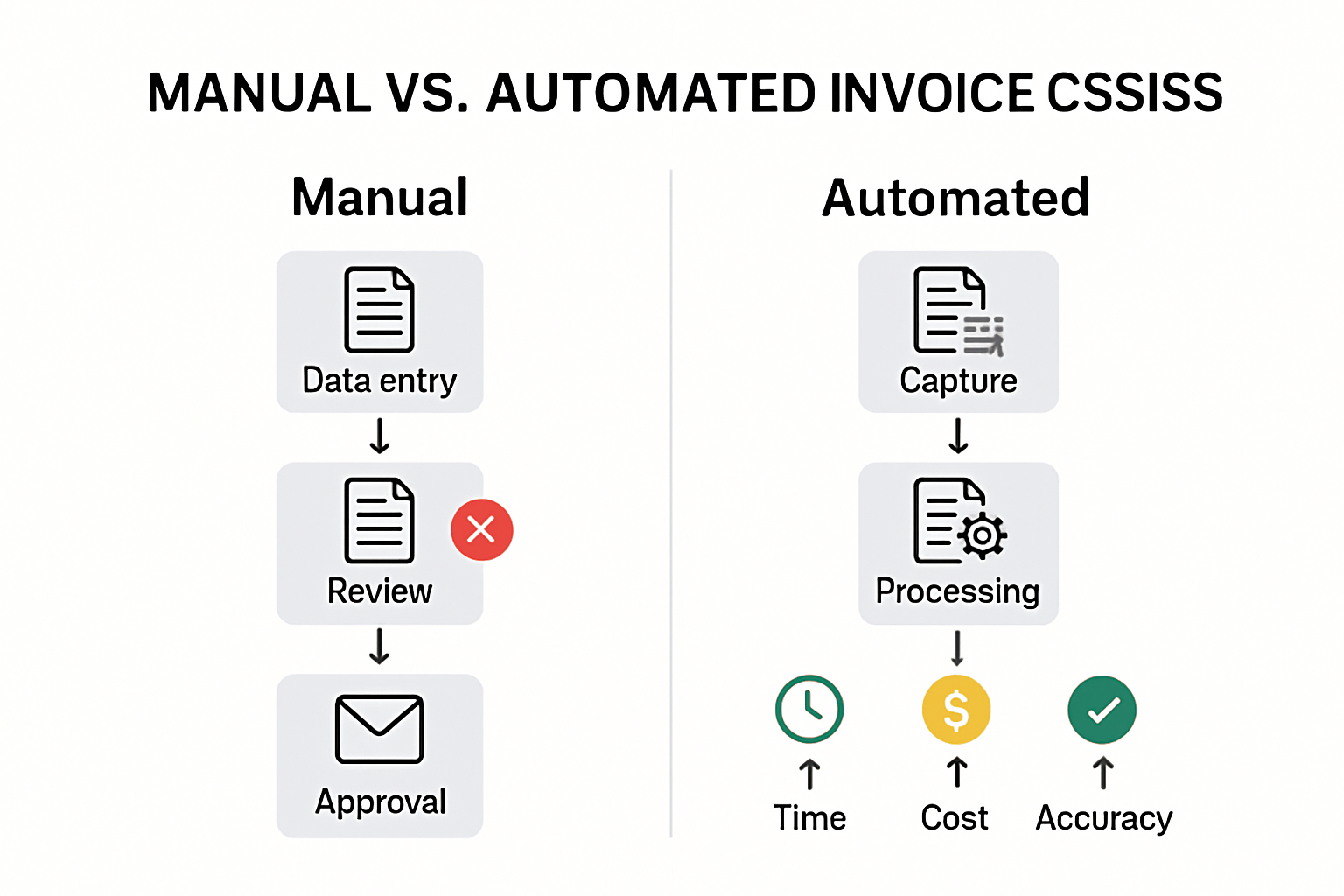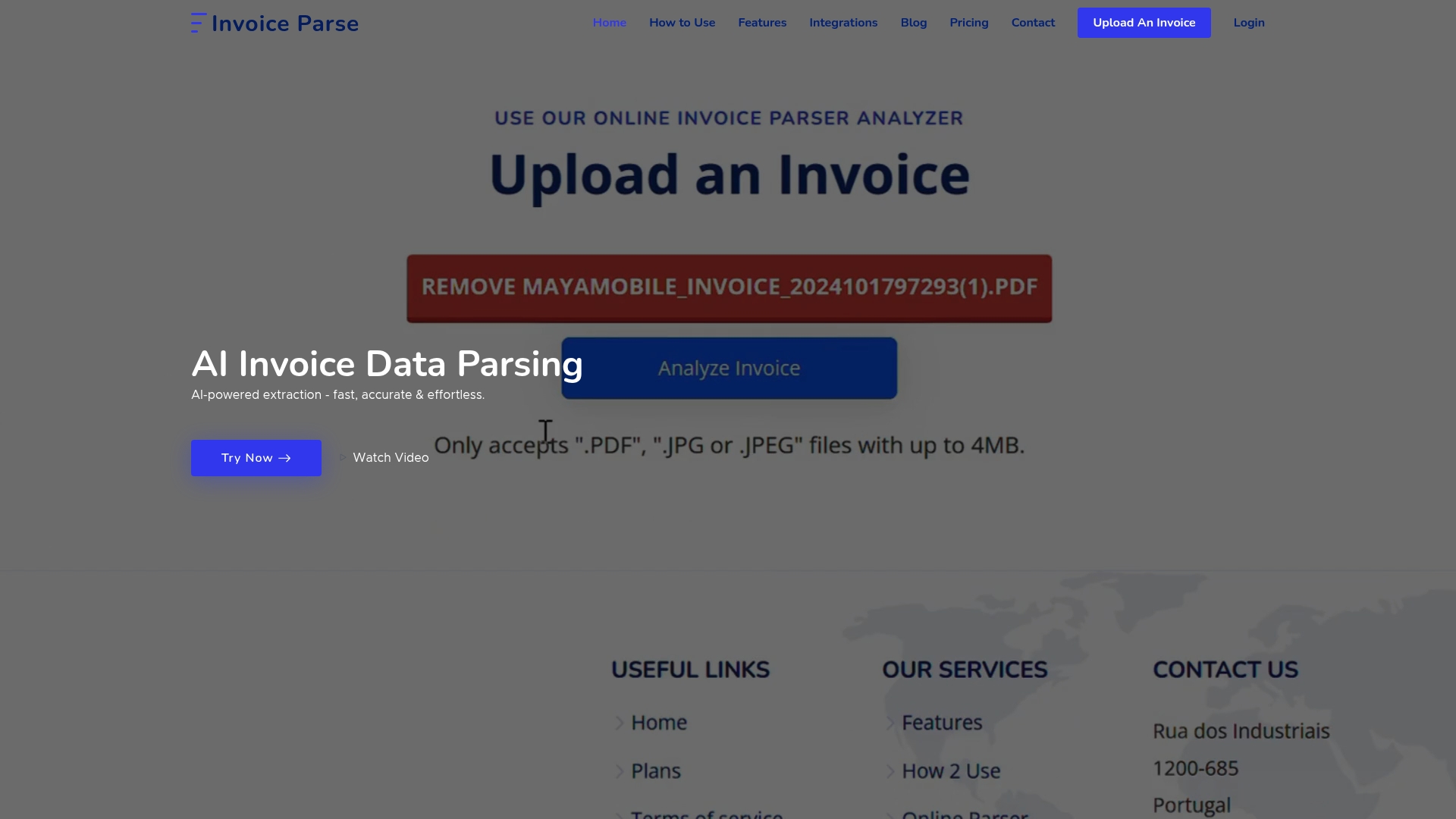Invoice processing might sound like a straightforward task, but hidden behind those stacks of paperwork and emails are surprising costs and errors. Most companies spend between $12 and $40 just to process a single invoice, even before factoring in mistakes and wasted time. What catches people off guard is that these expenses are only the tip of the iceberg, because the real trouble begins when outdated systems push finance teams into a cycle of delays, compliance risks, and missed opportunities that quietly drain profitability.

Top Challenges in Invoice Processing and How to Overcome Them
Table of Contents
- Common Invoice Processing Challenges Explained
- Impact Of Manual Processing On Businesses
- Best Solutions To Overcome Invoice Challenges
- How Automation Improves Invoice Workflows
Quick Summary
| Takeaway | Explanation |
|---|---|
| Manual invoice processing is costly. | Companies spend $12 to $40 per invoice, driven by inefficient manual tasks and high labor costs. |
| Automating data extraction reduces errors. | Advanced technologies like AI can accurately parse invoices, minimizing human error in data entry. |
| Implement comprehensive digital workflows. | Integrating robust digital processes can significantly enhance efficiency, reducing processing time and costs. |
| Focus on strategic technology adoption. | Evaluate specific needs and choose scalable, secure technology solutions for invoice management improvements. |
| Automation transforms financial workflows. | Implementing intelligent systems can speed up processing, cut costs, and redirect efforts to strategic initiatives. |
Common Invoice Processing Challenges Explained
Invoice processing remains a critical yet complex financial operation for businesses of all sizes. While technology continues to advance, organizations still struggle with numerous challenges that can significantly impact their financial efficiency and accuracy.
The Hidden Costs of Manual Invoice Management
Manual invoice processing is far more expensive than most businesses realize. Research by the National Automated Clearing House Association reveals that companies spend between $2 to $5 just to create and deliver a single paper-based invoice, with an additional $10 required for processing and payment. These substantial costs stem from labor-intensive practices that consume significant time and resources.
The inefficiencies are widespread. A 2022 study by The Institute of Financial Operations and Leadership discovered that 64% of finance teams in North America operate with outdated and inefficient processes, with accounts payable being the most problematic area. This statistic underscores the urgent need for systematic improvements in invoice processing workflows.
Data Extraction and Validation Challenges
Extracting accurate information from invoices presents a significant technical challenge. Traditional methods rely heavily on manual data entry, which introduces multiple potential errors. Documents with varying formats, partially handwritten sections, or low-quality images create additional complexity.
Advanced machine learning techniques are emerging as a solution. A groundbreaking research publication demonstrated how deep learning approaches can automate invoice document validation using sophisticated document layout analysis and object detection techniques. These innovations promise to dramatically reduce human error and processing time.
Compliance and Security Risks
Invoice processing is not just about speed and accuracy but also about maintaining rigorous financial compliance. Companies must navigate complex regulatory requirements while protecting sensitive financial data. Mistakes can lead to significant financial penalties, damaged vendor relationships, and potential legal complications.
The interconnected nature of modern financial systems means that invoice processing challenges extend beyond simple data management. They represent a critical intersection of technology, human expertise, and strategic financial management. By understanding these challenges, businesses can develop more robust, efficient, and secure invoice processing strategies.
To help visualize the key challenges in manual invoice processing and their associated impacts, here is a summary table of the main pain points discussed:
| Challenge | Description |
|---|---|
| High Processing Costs | Manual tasks result in $12–$40 cost per invoice. |
| Data Entry Errors | Human error leads to mistakes and payment delays. |
| Inefficient Workflows | Outdated processes slow down operations and approval. |
| Compliance and Security Risks | Mistakes and lack of controls can cause financial/legal issues. |
| Scalability Limitations | Manual systems can’t keep pace with business growth. |
| Opportunity Cost | Staff time spent on low-value tasks rather than strategy. |
Learn more about streamlining your invoice data extraction with our comprehensive AI-powered invoice processing guide.
Impact of Manual Processing on Businesses
Manual invoice processing represents a significant drain on business resources, creating cascading challenges that extend far beyond simple administrative inefficiency. Organizations continue to grapple with substantial financial and operational consequences when relying on traditional paper-based and manual invoice management systems.
Below is a comparison table summarizing the benefits of automated invoice processing versus manual processing, as described throughout the article:
| Aspect | Manual Processing | Automated Processing |
|---|---|---|
| Cost per Invoice | $12–$40 per invoice | Significantly reduced |
| Processing Time | Slow, labor-intensive | Fast, often real-time |
| Error Rate | High (due to manual entry & validation) | Low (due to AI/data validation) |
| Scalability | Limited, needs more staff as volume grows | Easily scalable with business growth |
| Security & Compliance | High risk, manual controls | Enhanced with digital safeguards |
| Staff Role | Low-value, repetitive tasks | Strategic, analytical focus |
Direct Financial Costs of Manual Processing
Research from IndustryWeek reveals the staggering expense of manual invoice processing. Processing a single paper invoice can cost between $12 and $30, with larger enterprises experiencing costs as high as $40 per invoice. These expenses stem from labor-intensive tasks such as data entry, document routing, verification, and manual reconciliation.
The University of Kansas provides a compelling case study demonstrating the potential for savings. By implementing automated purchase orders with key suppliers, they processed approximately 2,800 invoices annually and achieved $42,000 in productivity savings. Their strategic approach highlights how systematic improvements can dramatically reduce operational expenses.
Productivity and Error Reduction Challenges
Manual invoice processing introduces significant human error risks. Employees spending hours on repetitive data entry tasks are prone to mistakes that can lead to payment delays, duplicate payments, or incorrect financial reporting. These errors not only consume additional time to rectify but can also damage vendor relationships and potentially incur late payment penalties.
The time spent on manual processing represents an opportunity cost. Finance team members could instead focus on strategic financial analysis, budgeting, and business growth initiatives. By relegating talented professionals to mundane data entry tasks, businesses effectively reduce their strategic potential.
Long-Term Operational Implications
E-invoicing research demonstrates that digital transformation offers substantial benefits beyond immediate cost savings. Electronic invoicing enables instant sending and receiving, eliminates manual processing bottlenecks, and provides enhanced security through advanced encryption techniques. Companies adopting these technologies can accelerate payment cycles, improve vendor relationships, and create more transparent financial workflows.
Moreover, manual processing creates scalability challenges. As businesses grow, the complexity and volume of invoices increase exponentially. Traditional manual systems become increasingly unsustainable, requiring proportional increases in human resources to manage growing financial documentation.

Understand how modern businesses are transforming their invoice automation strategies to overcome these persistent challenges and unlock significant operational efficiencies.
Best Solutions to Overcome Invoice Challenges
Navigating the complex landscape of invoice processing requires strategic solutions that leverage modern technology and innovative approaches. Businesses can effectively address invoice challenges by implementing targeted strategies that reduce manual workload, enhance accuracy, and improve overall financial efficiency.
Automated Invoice Data Extraction
Advanced technological solutions now offer powerful alternatives to manual invoice processing. The National Association of Credit Management highlights the transformative potential of e-invoicing, which enables real-time tracking of validation, approvals, and payments. These systems dramatically reduce errors and provide enhanced reporting and analytics capabilities.
Artificial intelligence and machine learning technologies have revolutionized invoice data extraction. These sophisticated tools can automatically recognize and parse complex document formats, extract critical information with remarkable accuracy, and integrate seamlessly with existing financial systems. By eliminating manual data entry, businesses can significantly reduce processing time and minimize human error.
Comprehensive Digital Workflow Integration
The U.S. Department of the Treasury provides a compelling example of systematic invoice processing improvement. Their Invoice Processing Platform (IPP) demonstrates how a structured digital approach can yield substantial efficiency gains. The platform has enabled federal agencies to reduce processing costs for undisputed invoices by 54% and disputed invoices by 43%, showcasing the potential of integrated digital workflows.
Successful digital integration involves more than just technological implementation. It requires a holistic approach that includes:
- Standardizing invoice submission processes
- Implementing robust validation mechanisms
- Creating clear approval hierarchies
- Establishing automated routing and notification systems
Strategic Technology Adoption
Implementing invoice processing solutions is not a one-size-fits-all approach. Organizations must carefully evaluate their specific needs, existing infrastructure, and long-term financial goals. Key considerations include scalability, integration capabilities, security features, and potential return on investment.
Cloud-based solutions offer additional flexibility, allowing businesses to scale their invoice processing capabilities without significant upfront infrastructure investments. These platforms provide enhanced security, real-time collaboration, and seamless updates that keep pace with evolving technological standards.
Learn more about optimizing your invoice data extraction techniques and transform your financial processing workflows. By embracing innovative technologies and strategic approaches, businesses can convert invoice processing from a challenging administrative task into a streamlined, efficient operational advantage.

How Automation Improves Invoice Workflows
Automation has emerged as a transformative force in invoice processing, offering businesses unprecedented opportunities to streamline financial workflows, reduce errors, and enhance overall operational efficiency. By leveraging advanced technologies, companies can fundamentally reimagine their approach to invoice management.
Intelligent Document Processing Technologies
A groundbreaking study in the Journal of Electrical Systems reveals the remarkable potential of intelligent document processing frameworks. By combining computer vision, natural language processing, and robotic process automation, these technologies can analyze multilingual documents with exceptional accuracy. The framework demonstrates an ability to perform sophisticated document categorization and key information extraction using minimal training data.
The implications of such technologies extend far beyond simple data entry. Intelligent automation enables businesses to process complex financial documents with unprecedented speed and precision. Machine learning algorithms continuously improve their recognition capabilities, adapting to various document formats and reducing manual intervention.
Comprehensive Workflow Transformation
Research published in the Journal of Medical Internet Research highlights the profound impact of electronic invoicing across different sectors. By eliminating manual tasks, automation allows accounting teams to redirect their focus toward strategic initiatives. The benefits include faster payments, dramatically reduced processing costs, and significantly improved customer satisfaction.
A compelling case study demonstrates the transformative power of automation. An innovative research project integrating generative AI with intelligent document processing achieved remarkable results. The automated system reduced processing time for paper receipt expense tasks by over 80%, simultaneously decreasing error rates and enhancing compliance protocols.
Strategic Implementation and Future Potential
Successful automation is not merely about implementing technology but about creating a holistic strategy that aligns with organizational objectives. Key considerations include:
- Selecting scalable automation solutions
- Ensuring seamless integration with existing financial systems
- Maintaining robust data security protocols
- Providing comprehensive staff training
The future of invoice processing lies in adaptive, intelligent systems that can learn, improve, and respond dynamically to changing business requirements. Cloud-based platforms and AI-driven technologies are making these advanced capabilities increasingly accessible to businesses of all sizes.
Discover how invoice automation can revolutionize your financial workflows and unlock new levels of operational efficiency. The journey toward intelligent invoice processing represents not just a technological upgrade but a strategic transformation of financial management.
Frequently Asked Questions
What are the main challenges in invoice processing?
The main challenges in invoice processing include high processing costs due to manual tasks, data extraction and validation errors, compliance and security risks, and inefficiencies in workflows that can lead to payment delays.
How can automation improve invoice processing efficiency?
Automation improves invoice processing efficiency by reducing manual errors, speeding up data extraction, and streamlining workflows. Advanced technologies like AI and machine learning allow for accurate data parsing and faster processing times.
What are the financial implications of manual invoice processing?
Manual invoice processing can cost businesses between $12 and $40 per invoice. These costs arise from labor-intensive tasks and can lead to additional expenses due to errors, payment delays, and compliance risks.
Why is compliance important in invoice processing?
Compliance is crucial in invoice processing because it ensures adherence to regulatory standards, reduces the risk of financial penalties, and safeguards sensitive financial data from security breaches.
Take Control of Invoice Processing: Turn Challenges Into Opportunity
Manual invoice processing often means costly errors, slow approval cycles, and missed financial insights discussed throughout this article. If chasing down accurate data or fixing mistakes feels all too familiar, you are facing the exact pain points that threaten profitable growth and business efficiency. Complex formats, compliance stress, and the never-ending battle against time can drain even the best teams.

It is time to break out of outdated methods. With Invoice Parse, you get instant, reliable invoice data extraction with no templates and no technical setup required. Upload invoices in PDF or image format and see vendor names, totals, dates, and every line item captured accurately in seconds. You can send results straight to Excel or your workflow tools without retyping anything. See how effortless it is to move from manual work to real efficiency. Ready to eliminate errors and cut your costs? Experience powerful automation for yourself by starting today at Invoice Parse. For step-by-step help, explore our video guides and educational resources.
Recommended
- AI Invoice Parse – Extract Invoice Data Guide: Best Practices for 2025
- AI Invoice Parse – Automated Invoice Reconciliation: Save Time and Reduce Errors
- AI Invoice Parse – Invoice Data Guide: Efficient Processing in 2025
- AI Invoice Parse – Invoice Audit Checklist: Key Steps for Accurate Reviews
- Step by Step guide to Odoo Invoicing by Bista Solutions
- Automating Business Processes with Adobe PDF Solutions - Mapsoft
